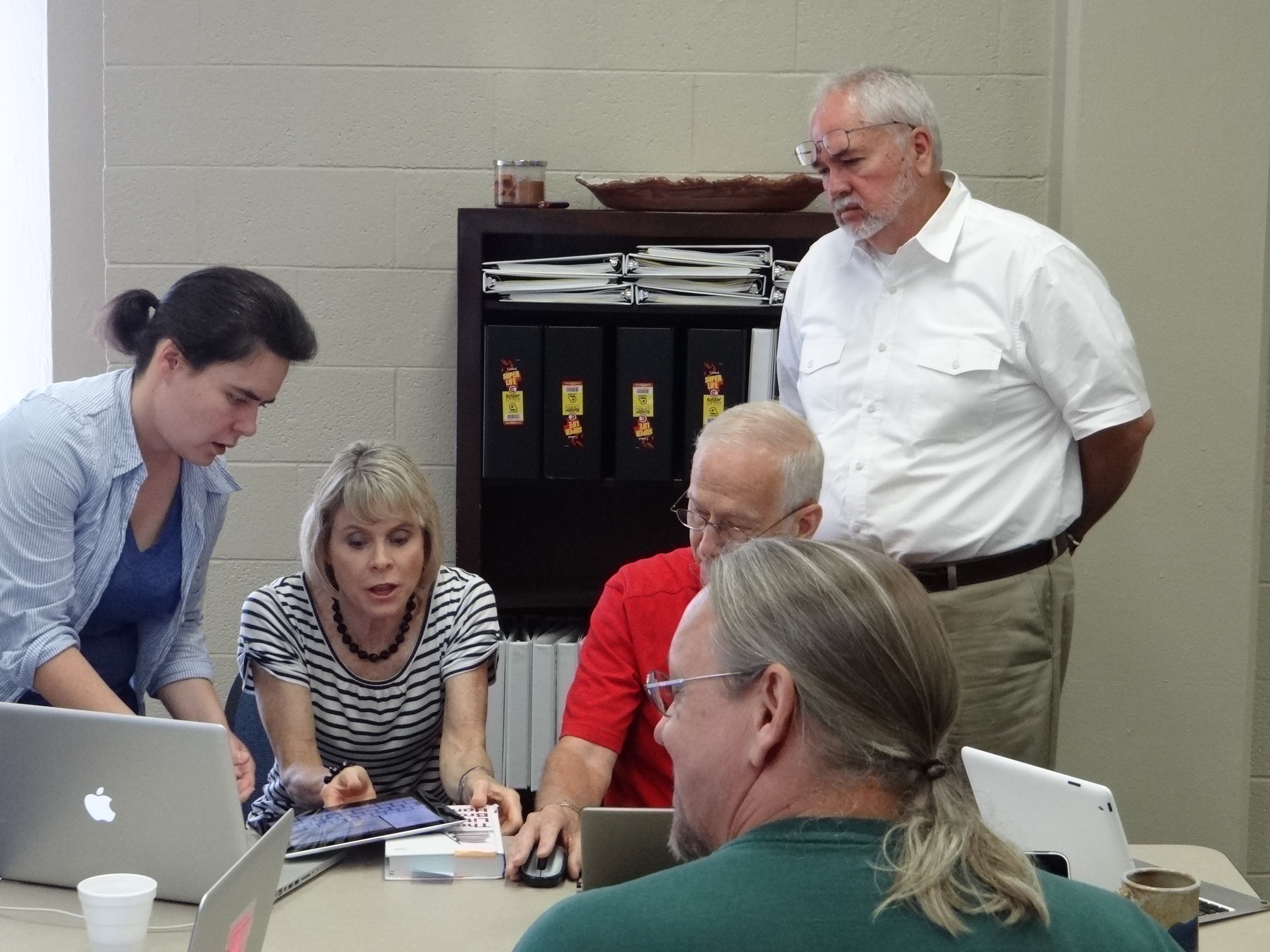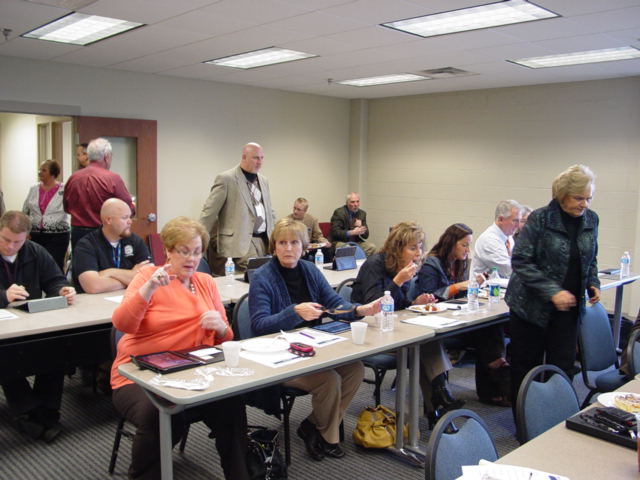Training for Mobile Learning: Moving from the Basics to Redefining Learning
Published by: WCET | 10/29/2013
Tags: Collaboration/Community, Faculty, Mobile Learning, Teaching
Published by: WCET | 10/29/2013
Tags: Collaboration/Community, Faculty, Mobile Learning, Teaching
This is the second in a series of blog posts from our friends at Walters State Community College in Tennessee. The first post covered how they organized campus-wide implementation of their mobile learning initiative. This post focuses on steps in training faculty and staff– from basic tasks to redefining the student learning experience.
Russ Poulin
In January of 2011 on these pages, WCET Executive Director Ellen Wagner predicted “in all of its rich and nuanced forms [mobile learning] will finally become an obvious, self-evident solution for learning because we are finally focusing on meeting the needs of learners who are mobile.” In Fall of that same year, an Instructional Design Team (consisting of technical personnel, instructional support personnel, and faculty) at Walters State Community College did our best to make that prediction come true with help from our IT department.
Faculty and academic staff had iPads in hand at our institution. It was our job to help faculty enhance student learning outcomes and student engagement through mobile learning. We started with training, a fairly ordinary thing to do.
Initial Faculty and Staff Training Required “Meeting Them Where They Are”
Here is a sample of an early training session from Fall 2011:
Maybe not a very ambitious training outline, but it stood us in good stead as we stood in front of faculty and staff who were all over the place—those who could operate their iOS smart devices with the best of ‘em, those who had Android “flip phones” that they might be able to answer a call on (at best), and most who were somewhere in the middle.
The point was to meet faculty and staff where they were. For many it was one-on-one sessions focusing on how to use Safari, how to set up an iTunes account, and how to search for and download a free app. Other faculty did well in training sessions of 10 to 15 participants.
At that time, if we merely sent out an “all call” announcement for training, our sessions filled up quickly. Folks wanted to know how to operate the new devices in their hands and wondered if they might be able to use them with students. We underestimated the demands of showing faculty and staff the basics and how to set up and get started on the devices. We underestimated that huge gap between digital almost-natives and those faculty and staff who were entirely new to the iTunes/Apple world on our PC campus. A one-size fits all training model does not work effectively every time, but it did start getting the training done, with plenty of calls to invite faculty and staff to return for one-on-one sessions after a group training event.
 After Two Years, Training Needs Delve Deeper Into Learning Theory and Outcomes
After Two Years, Training Needs Delve Deeper Into Learning Theory and Outcomes
Roll the clock forward two years later, and compare a training outline for a one-day session tailored for our nursing faculty, as we covered:
Operating the devices is now fairly well a given for faculty and staff. And they are ready to tackle bigger problems of fine-tuning connecting apps to student learning outcomes and engagement, as well as assessment of both. They are beginning to think about students creating their own classroom presentations using the huge array of apps that create, house, and distribute content.
Now, as we start talking about Bloom’s taxonomy and pushing out the “bottom” two layers on the Bloom’s taxonomy for mobile learning outside the classroom (and, yes, there’s an app for that—and, of course, more than just one), we are beginning to have faculty interested in the flipped classroom approach through mobile learning. We are beginning to offer training that shows faculty how to use mobile devices in order to have students create and share content inside the classroom, once content and learning at the recall/recognition and comprehension/understanding levels of Blooms are pushed outside the classroom.
The SAMR Model Helps Conceptualize Our Progress in Mobile Learning
Now, we are using the SAMR model to guide us with how faculty progress in mobile learning. In training, we give examples of the SAMR levels and discuss activities faculty might carry out with their students that correspond to the various levels of the model.
To integrate teaching/learning activities, their relationship to Blooms Taxonomy, and to the SAMR model, we use the graphic produced by Alan Carrington. We have printed and mounted the graphic as a poster and are in the process of delivering the poster to each of our eight academic divisions and to all our campuses so that faculty, staff, and administrators can refer to the poster and search for apps and tools on their own.
As the SAMR model predicts, faculty seem to naturally begin at the Substitution level of the SAMR model and gravitate toward the higher levels as they become more comfortable with the technology, how it works, and how to integrate mobile learning into their on-going instruction and curriculum. We encourage faculty members to push their comfort level as much as possible without overwhelming them. As trainers, we notice that individual division/department leadership has a profound effect on the SAMR level of its constituent faculty. Also, the SAMR model becomes a scaffold inside our heads as trainers as we work with individual faculty one-on-one, again attempting to push faculty to the next level of the hierarchy as possible while still respecting their control of the classroom, student learning, curriculum, and assessment.
We are working toward most faculty members ultimately reaching the Redefinition level. It’s a start. It’s a work in progress. And, as the Apple people say, “Exciting times.”
David White
Assistant Dean of Online Instruction and Professor of English
Walters State Community College
david.white@ws.edu
The final post in this series will focus on the IT infrastructure and support required for a large scale mobile learning initiative.
4 replies on “Training for Mobile Learning: Moving from the Basics to Redefining Learning”
Hi David
Thank you for a great post! We do something similar with Blooms in our @ONE courses. The lower the level in Blooms, the less designed activity is involved. As you move up the levels, the more interactive the activities in the course need to become. We have our teachers match the learning activity to each outcome in a unit of study. They quickly start to see the patterns for developing the activities (video or written lecture, scenario analysis, student blog post, student presentation creation, etc.).
Focusing on outcomes and then designing appropriately, very quickly becomes a natural thing for good teachers.
Pat James
Dean of Distance Education
@ONE Trainer and Course Designer
Mt. San Jacinto College
Menifee, California
Hi David
Thank you for a great post! We do something similar with Blooms in our @ONE courses. The lower the level in Blooms, the less designed activity is involved. As you move up the levels, the more interactive the activities in the course need to become. We have our teachers match the learning activity to each outcome in a unit of study. They quickly start to see the patterns for developing the activities (video or written lecture, scenario analysis, student blog post, student presentation creation, etc.).
Focusing on outcomes and then designing appropriately, very quickly becomes a natural thing for good teachers.
Pat James
Dean of Distance Education
@ONE Trainer and Course Designer
Mt. San Jacinto College
Menifee, California
[…] « Training for Mobile Learning: Moving from the Basics to Redefining Learning […]
[…] « Training for Mobile Learning: Moving from the Basics to Redefining Learning […]